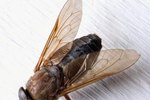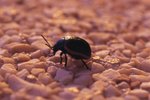
Sandy terrain comes in several forms and each has its insect inhabitants. Beaches, sand dunes and deserts, even a backyard sandpit, are home to an array of insects. Most beach-dwelling insects are harmless to humans, as are the sand dune bugs, but some of the numerous sand fly species spread disease by feeding on blood.
Beaches
Although seaweed doesn't live on sandy beaches, high tides often throw up piles of drifting seaweed. Kelp flies feed on rotting seaweed and are particularly attracted to bladder kelp, which they use as a place to lay eggs. You may also notice tiny red mites among piles of dried seaweed. There are some 100 tiger beetle species in the United States. The northeastern tiger beetle, which typically lives around New England shores, is under threat from spider and wasp predators, and from vehicle access to beaches.
Great Sand Dunes
The Great Sand Dunes national park in Colorado provides a habitat for a range of endemic insect species. Endemic means these insects are not found elsewhere. One native is the Great Sand Dunes tiger beetle, which hunts for ants and mites on the sand's surface. The circus beetle, who feeds by scavenging, performs a headstand and emits a smelly substance to warn off predators. Ant-like flower beetles are tiny, yellowish and feed on dead insects. The clown beetle has a shiny, cylindrical body. He relies on the wind to blow his round body to new locations and he's usually found in the grassy parts of sand dunes. The robber fly is one of the areas largest insects at an inch in length. He likes to feed on other flying insects at the hottest time of the day.
Antlion
The antlion is a giant of the ant world. He feeds on other ants and the larvae hide in pieces of driftwood and attack passing insects. In sandy parts, he digs a shallow pit and hides at the bottom, waiting for his prey to fall into the hole. This particular type of antlion is also called a doodlebug because he leaves traces of activity in the sand that look like artistic doodles. If you spot concentric spirals in the sand, it marks the spot of an antlion pit trap. The adults are similar to dragonflies in appearance, but are poor fliers. You are unlikely to see an adult antlion on the beach during the day, as he only emerges under cover of darkness.
Sand Fly
There are about 700 species of sand flies that feed on blood, and 70 of them pass disease to humans and pets. The Lutzomyia shannoni species is of particular interest to scientists and public health officials in the U.S. because it spreads leishmaniasis and sand fly fever. It is more prevalent in the southern states of the U.S. Only the female feeds on blood, which she needs to mature her eggs. Not all sand fly species, which also includes biting midges, spread disease, but they can give you an irritating bite. Sand fly species live around coastal areas and favor intertidal zones, and wetter terrain than some other sand dwellers.
References
Photo Credits
-
Comstock Images/Comstock/Getty Images
Writer Bio
Based in London, Eleanor McKenzie has been writing lifestyle-related books and articles since 1998. Her articles have appeared in the "Palm Beach Times" and she is the author of numerous books published by Hamlyn U.K., including "Healing Reiki" and "Pilates System." She holds a Master of Arts in informational studies from London University.




